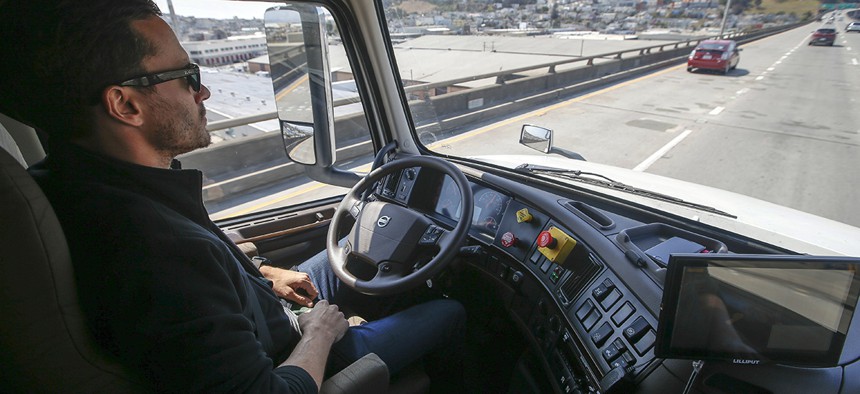The U.S. Might Need Self-Driving Trucks to Avoid a Labor Shortage Crisis

Matt Grigsby, senior program engineer at Otto, takes his hands off the steering wheel of a self-driving, big-rig truck during a demonstration on the highway, in San Francisco. Tony Avelar/AP File Photo
The trucking industry had a shortage of 51,000 truck drivers at the end of last year.
The autonomous car industry is booming. Waymo has turned a moonshot self-driving car project into actual vehicles that only need human intervention every 30,000 miles, and perhaps thanks to Elon Musk’s attempts to distract from its crashes, Tesla’s Autopilot feature remains legal.
Tesla and Waymo are also working on building autonomous semi-trailer trucks, meant to automate the task of driving goods around the U.S. Human truckers have expressed worry and disbelief about the technology, but it might burgeon at the perfect time for the struggling transportation industry. Right now, there aren’t enough truckers.
The trucking industry had a shortage of 51,000 truck drivers at the end of last year, American Trucking Association chief economist Bob Costello told the Washington Post. That number is on the rise, up from 36,000 at the end of 2016. The ATA attributes the growth of the sector to a boom in online shopping, with Amazon leading the way. People want things from far away, and they want it now. It’s only getting worse: The ATA says the trucking industry needs to hire 900,000 more drivers in the next 10 years to keep up with demand.
There’s no clear answer to why the job isn’t appealing to younger people. The average age of American truck drivers is 55, more than 10 years older than the median age of the U.S. workforce. Some cite the looming specter of autonomous vehicles, and others cite the long hours and low wages. Recent federal legislation mandates electronic logging of every mile driven, making it tougher for truckers to fudge the numbers to fit multiple deliveries into a short amount of time.
The allure of driving Tesla’s electric semi-trailer—as well the reduced burden of the job thanks to semi-autonomous features like Autopilot—might be enough to bring some new blood into the industry in 2019, when the company says it will release those trucks. Waymo’s autonomous semi-trailers are expected to carry freight even sooner, as early as later this year.
Costello told the Post the answer to the trucking labor shortage could be simply making logistics smarter: Take Uber’s algorithmic approach for taxis, and make something similar for semi-trailer trucks.


